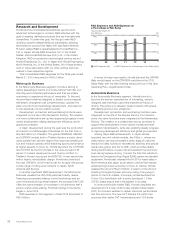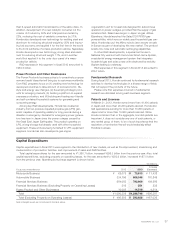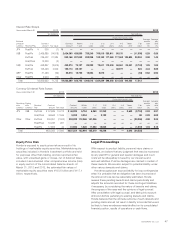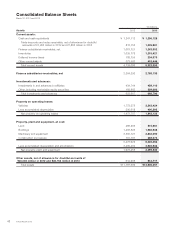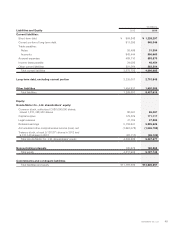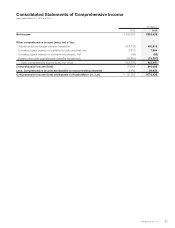Honda 2013 Annual Report Download - page 45
Download and view the complete annual report
Please find page 45 of the 2013 Honda annual report below. You can navigate through the pages in the report by either clicking on the pages listed below, or by using the keyword search tool below to find specific information within the annual report.impaired, impairment losses to be recognized is measured
by the amount by which the carrying amount of the operat-
ing leases exceeds the estimated fair value of the operat-
ing leases.
We believe that our estimated losses on lease residual
values and impairment losses is a “critical accounting esti-
mate” because it is highly susceptible to market volatility and
requires us to make assumptions about future economic
trends and lease residual values, which are inherently uncer-
tain. We believe that the assumptions used are appropriate.
However actual losses incurred may differ from original esti-
mates as a result of actual results varying from those
assumed in our estimates.
If future auction values for all Honda and Acura vehicles in
our North American operating lease portfolio as of March 31,
2013, were to decrease by approximately ¥10,000 per unit
from our present estimates, holding all other assumption
constant, the total impact would be an increase in deprecia-
tion expense by approximately ¥3.8 billion, which would be
recognized over the remaining lease terms. Similarly, if future
return rates for our existing portfolio of all Honda and Acura
vehicles were to increase by one percentage point from our
present estimates, the total impact would be an increase in
depreciation expense by approximately ¥0.2 billion, which
would be recognized over the remaining lease terms. With
the same prerequisites shown above, if future auction values
in our North American direct financing lease portfolio were to
decrease by approximately ¥10,000 per unit from our present
estimates, the total impact would be an increase in losses on
lease residual values by approximately ¥0.2 billion. And if
future return rates were to increase by one percentage point
from our present estimates, the total impact would be slight.
Note that this sensitivity analysis may be asymmetric, and are
specific to the base conditions in fiscal 2013. Also, declines
in auction values are likely to have a negative effect on return
rates which could affect the sensitivities.
Fiscal Year 2013 Compared with Fiscal Year 2012
Losses on lease residual values on direct financing leases
declined by ¥0.6 billion, or 47%. Incremental deprecation on
operating leases increased by ¥6.7 billion, due mainly to
declines in used vehicle prices in North America compared
with fiscal year 2012 which showed near historical high.
No impairment losses as a result of declines in estimated
residual values were recognized during fiscal year 2013.
Pension and Other Postretirement Benefits
We have various pension plans covering substantially all of
our employees in Japan and certain employees in foreign
countries. Benefit obligations and pension costs are based
on assumptions of many factors, including the discount rate,
the rate of salary increase and the expected long-term rate of
return on plan assets. The discount rate is determined mainly
based on the rates of high quality corporate bonds currently
available and expected to be available during the period to
maturity of the defined benefit pension plans. The salary
increase assumptions reflect our actual experience as well as
near-term outlook. Honda determines the expected long-term
rate of return based on the investment policies. Honda con-
siders the eligible investment assets under investment poli-
cies, historical experience, expected long-term rate of return
under the investing environment, and the long-term target
allocations of the various asset categories. Our assumed
discount rate and rate of salary increase as of March 31,
2013 were 1.5% and 2.2%, respectively, and our assumed
expected long-term rate of return for the year ended March
31, 2013 was 3.0% for Japanese plans. Our assumed dis-
count rate and rate of salary increase as of March 31, 2013
were 4.5~4.7% and 2.5~4.1%, respectively, and our
assumed expected long-term rate of return for fiscal 2013
was 6.2~7.7% for foreign plans.
We believe that the accounting estimates related to our
pension plans is “critical accounting estimate” because
changes in these estimates can materially affect our financial
condition and results of operations.
Actual results may differ from our assumptions, and the
difference is accumulated and amortized over future periods.
Therefore, the difference generally will be reflected as our
recognized expenses in future periods. We believe that the
assumptions currently used are appropriate, however, differ-
ences in actual expenses or changes in assumptions could
affect our pension costs and obligations, including our cash
requirements to fund such obligations.
The following table shows the effect of a 0.5% change in
the assumed discount rate and the expected long-term rate
of return on our funded status, equity, and pension expense.
Honda Motor Co., Ltd. 43





